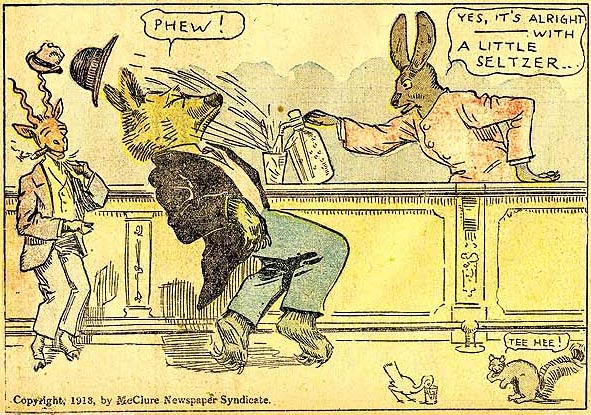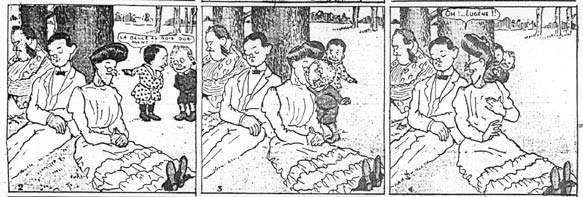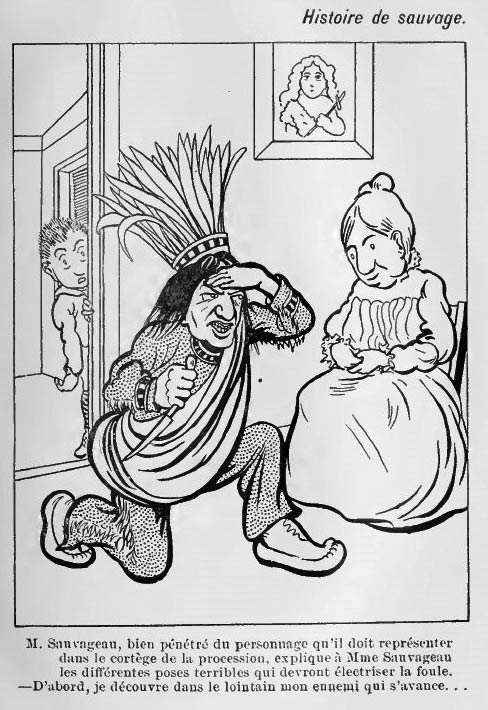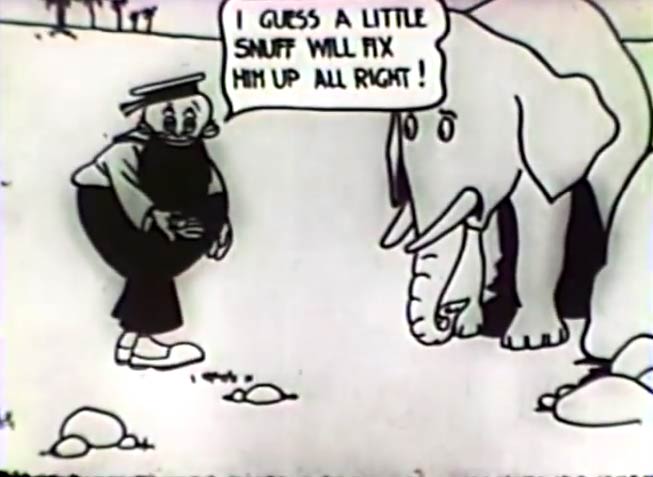'Noahzark Hotel'.
Raoul Barré was one of the pioneers of the French-Canadian comic strip, along with Albéric Bourgeois, Joseph Charlebois, René-Charles Béliveau and Th. Busnel. Among his creations were 'Pour un Dîner de Noël' (1902), 'Histoire de Sauvage', 'Les Contes du Père Rheault' (1906) and Noahzark Hotel' ('À l'Hôtel du Père Noél', 1913). Also a pioneer of animation, Barré invented the peg and slash system, prominent animation techniques used until the 1930s. He also discovered how to portray horizons and pan movements in animation. Barré was additionally the first person in history to establish an animation studio and the first to create an animated series around one recurring character. In the 1910s, his studio adapted several popular newspaper comics into animated shorts.
Early life
Vital Achille Raoul Barré was born in 1874 in Montréal, Canada, as one of twelve children of a communion wine importer. After studying at the Institut du Mont Saint-Louis in Montréal and le Conseil des Arts et Manufactures, he published his first illustrations in magazines like Monde Illustré and Le Passe-temps. In the spring of 1896, Barré moved to Paris, where he studied at the Académie Julian and École des Beaux-arts. Around the same time, Barré contributed caricatures to the magazines Le Sifflet, Le Cri de Paris, Le Gavroche, Les Débats, La Revue des Deux Frances and La Gaîté Gauloise. Barré didn't limit his political opinions to just drawing. When the French military officer Alfred Dreyfus was put on trial for treason, Barré was one of the few people who realized antisemitism was the real reason for his dismissal. Barré was a fierce critic of the Dreyfuss trial, making him a diametric opponent of another cartoonist and future animation pioneer, Émile Cohl. In 1898, Barré returned to Québec. He lived to see Dreyfuss rehabilitated and cleared of all charges in 1906.
'Pour un Diner de Noël'.
Early comics
In 1900, Barré became a frequent collaborator of the Montréal newspaper La Presse. His pantomime comic 'Pour un Dîner de Noël' was published in La Presse on 20 December 1902 and is considered the first Quebecan comic strip. In eight panels, it tells the story of a family of three trying to catch a duck for their Christmas diner. Barré continued to work for the paper until 1908, producing many picture stories and cartoons, some of them with speech balloons, on the 'En Roulant Ma Boule' page. This included the cartoon feature 'Histoire de Sauvage'. A book collection of 'En Roulant Ma Boule' was published by Librairie Déom Frères. Another comic strip, 'Les Contes du Père Rheault' (1906), appeared in color in La Patrie and also featured speech balloons.
In addition to his newspaper work, Raoul Barré illustrated novels by Henri Julien. He published under the pseudonyms "Raoul Barry" and "VARB" and moved to New York City in 1913, where he began an association with the McClure Newspaper Syndicate. That same year, his comic strip 'Noahzark Hotel' was distributed by the same syndicate. A funny animal comic, set in a hotel, the feature was published in The New Haven Union between 12 January and 9 November 1913 and also ran in La Patrie under the title 'À l'Hôtel du Père Noél'.
'Les Contes du Père Rheault' (25 August 1906).
Animation career
In 1912, Raoul Barré first ventured into animation. He started out at the Edison Studios, where he met Bill Nolan, a producer of live-action shorts who eventually became his business and creative partner. Together, they made several animated advertisements, and pioneered the peg system to keep animated drawings in the exact same order and same place on paper. Barré also developed the "slash system", which kept the background drawings and the character drawings separate, before combining them while filming every image. This system remained in use until the 1930s, but was eventually replaced by the more efficient cel animation system, developed by Earl Hurd.
'Histoire de Sauvage'.
Barré-Nolan Studio
In 1914, Raoul Barré and Bill Nolan founded their own studio, Barré-Nolan. This was the first animation studio in history, even though their attempt was moderate compared with the more professional factory-based studios that followed later. In May 1915, they launched one of the first animated series centered around one character, 'The Animated Grouch Chasers', distributed by the Edison Studios. It was notable for combining animation with live-action. Together with Gregory LaCava and Frank Moser of William Randolph Hearst's International Film Service, they also worked on a series of "Phables", based on the comic strip by Tom Powers. Among the people who worked for Barré-Nolan were Gregory LaCava, Jack King, Frank Moser, Tom Norton, Clarence Rigby, George Vernon Stallings and Pat Sullivan. In 1916, Hearst's International Film Service hired away most of Barré's animators, including Nolan. Barré became a contractor to IFS, but only stayed for seven films.
One of Barré's 'Animated Grouch Chasers'.
Barré-Bowers Studio
In 1916, Raoul Barré and fellow animator Charles Bowers founded the Barré-Bowers Studios. Bowers had previously made animated films based on Rudolph Dirks' 'Der Katzenjammer Kids' and Frederick Burr Opper's 'Happy Hooligan'. Together, they made an animated version of Bud Fisher's comic strip 'Mutt and Jeff'. Among the people employed in their studio were Mannie Davis, F.M. Follett, Burt Gillett, Manny Gould, Milt Gross, Dick Huemer, Albert Hurter, Isadore Klein, Walter Lantz, Carl Lederer, Tom Palmer, George Ruffle, George Vernon Stallings, Ted Sears, Ben Sharpsteen and Bill Tytla.
Barré retired from animation in 1919, amidst rumors of a nervous breakdown. Tensions had been high in the studio, particularly because Bud Fisher often took credit for all of the work, while in reality he rarely visited the place. Barré became an oil painter and poster designer, after which the company was renamed the Bud Fisher Studio. Fisher soon fired Bowers over a financial dispute on how the studio was run, which also meant the end of the 'Mutt & Jeff' animated series. He rehired Bowers in 1920, but later fired him again, since he padded the studio payroll and was involved in other shady dealings too.
In 1926, Barré became an animator for Pat Sullivan's 'Felix the Cat' series. At his studio, he was involved with 'Eveready Harton in Buried Treasure' (1929), the first "adults only" cartoon in history. A collection of naughty pornographic jokes, it was allegedly intended for a party to honor Winsor McCay's birthday. According to Disney animator Ward Kimball, the film was made as a collaboration between the Barré, Max Fleischer and Paul Terry studios, who all animated certain scenes without each other's knowledge. Among the animators who worked on the picture were George Canata, Walter Lantz, George Vernon Stallings and Rudy Zamora Sr. Other sources claim that the short was too risqué to be processed by any lab at the time, which led the footage to sink into obscurity until the 1970s.
Final years and death
In 1928, Raoul Barré retired from the animation industry again, this time for good. He kept making paintings and political cartoons for Le Taureau under the pseudonym "É. Paulette" and started his own art school. In 1932, Raoul Barré died of cancer in Montreal at the age of 58.








